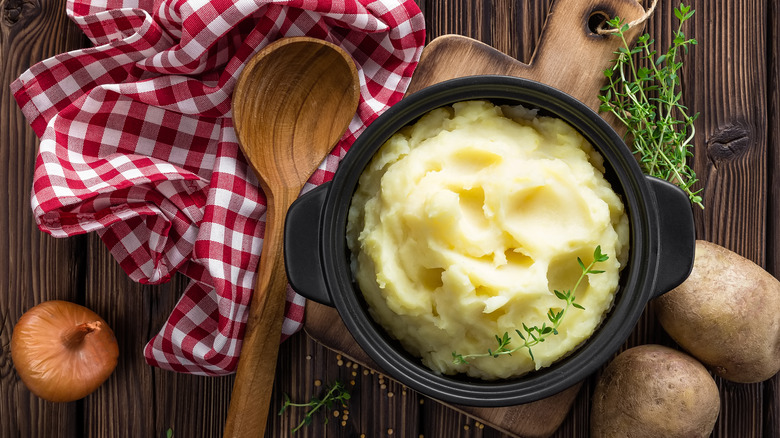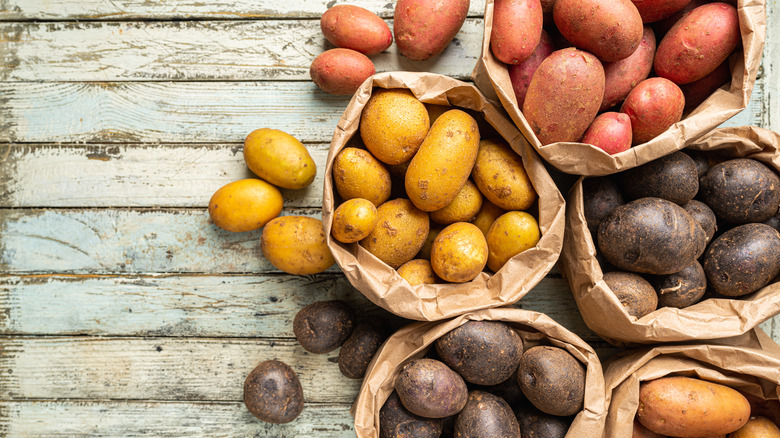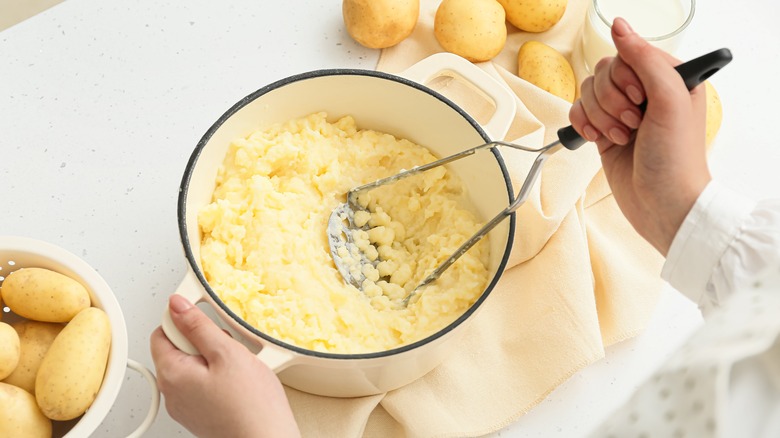Here's How Many Spuds You Need For A Batch Of Mashed Potatoes
As the holiday season gets underway, it's time to figure out your shopping list for preparing family dinners. Particularly with larger gatherings, it's important to figure out how much food you need ahead of time to feed your guests.
When it comes to mashed potatoes, it can get a little tricky. But a general calculation is you should always base your estimate off of the weight of uncooked potatoes; yet, even so, estimates are all over the spectrum. Smaller servings, for instance, may consist of only 4 ounces per person, while larger servings may go all the way up to 12 ounces. Serving sizes may also vary from one person to the next, or even be based on how many other side dishes are available. You have to save room for everything, after all!
As such, a good rule of thumb is to assume an average of 8 ounces of uncooked potatoes per guest (or about a pound for every two guests). Again, you want to go by weight rather than number of potatoes because spud sizes widely vary. However much your bag of potatoes weighs, double it to calculate how many people you can feed, and it'll be as easy as pumpkin pie to come up with the right amount.
Choosing the best spuds for your mashed potatoes
This may come as a surprise, but not all potatoes are made equal — at least not when it comes to using them for mashed potatoes. In other words, different varieties have their own textures that will result in creamier or fluffier mashed potatoes. What's more, each variety has its own range of sizes, which is why it's important to determine how many to buy based on weight.
To choose the best potatoes for your holiday side dish, first consider the desired end product. For instance, the best potatoes for thick mashed potatoes are waxy varieties like Yukon golds, reds, and long whites. These potatoes all have a denser, firmer texture and will create mashed potatoes with similar characteristics. Because they're denser, these varieties will also be more difficult to mash and incorporate with dairy.
On the other hand, for fluffier mashed potatoes, you should use floury varieties like russets or sweet potatoes. With higher levels of starch and lower levels of moisture, floury (a.k.a. starchy) potatoes have an airy texture that will translate to their mashed counterparts. Long story short, if you want cloud-like mashed potatoes, your best bet is a floury potato.
How to achieve perfect mashed potatoes
To be clear, you can make basic mashed potatoes whichever way works best for you. That being said, some methods can help you achieve a dreamier and creamier mash, starting with how you prepare your potatoes for boiling.
Regardless of the type of potato you choose, consider chopping them into chunks before boiling for a more even cook — but not any smaller than an inch and a half, as you don't want them to overcook or become waterlogged and mushy. As noted previously, we're calculating servings based on weight, not potato size, so this step shouldn't affect how much each guest gets.
Of equal importance, take care when mashing your potatoes. The more you mash them, the more starches they release. In turn, these starches make the potatoes more gluey, which is already a common problem with waxy varieties. Instead, consider adding a step to rinse the potatoes between cooking and mashing to eliminate excess starch, and then treat them gently.



